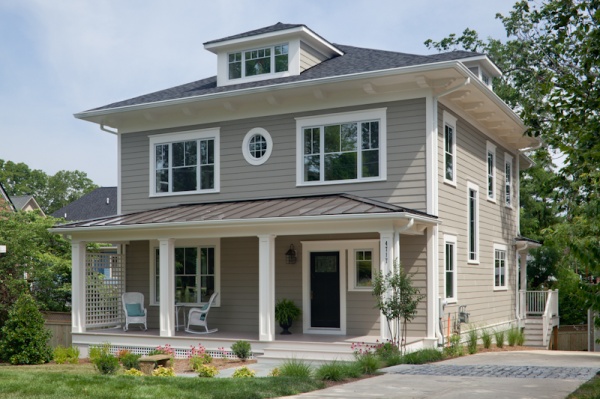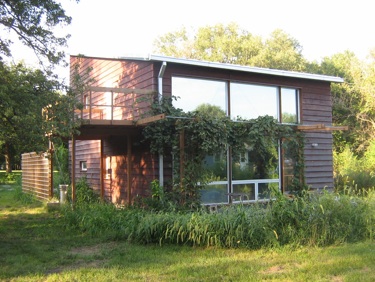Hi folks, I just heard from Beth. She and Whit and their trainer Chris are off for a big test this morning: New York City. A combination of rides on commuter trains, subway trains, and buses–plus negotiating the sidewalks full of New Yorkers. Everyone’s determined to make a city dog of Whit, and I have every confidence she’ll become one.
Only a week to go now, and while the first few days really crawled along, last week flew by. While Beth’s been at Paw Camp, I’ve been spending more time working at the Passive House Institute US office in Urbana, Ill. (I usually split my time between there and my home office in Chicago, but with Beth away, Urbana’s seen more of me lately). We’re gearing up for another year of training architects, engineers, builders and others to design, build and test Passive House buildings. I think Beth explained Passive House in another blog post –a building that is certified to meet the Passive House standard uses only 10 to 20 percent of the energy an equivalent conventional building uses.
There’s no magic involved, and there’s no waiting on hydrogen fuel cells or other pie-in-the-sky technology. Basically, you just:
- Insulate the bajeesus out of the building–the wall structures are designed to accommodate thick insulation
- Create a supertight “envelope”–just think of the outer skin of your home, and imagine if it didn’t leak air
- Use superb windows–they’re triple-paned, and even the frames and sashes have high insulation values
- Use energy recovery ventilation instead of a conventional furnace–an ERV transfers heat from exhaust air to incoming fresh air, so hardly any heat energy from the interior (generated by appliances, humans, and such) is lost
One of the cool things about Passive House design and construction is that buildings can look any way you want them to look: Contemporary and sleek or stately and traditional. The method has been used to build everything from single-family homes to large townhouse developments to high-rises. Passive Houses stay cool in the summer and warm in the winter–I’ve been in them and they’re unbelievably comfortable, draft-free, and the indoor air quality is superb. I want one someday.

A Passive House can look like this traditional foursquare in Bethesda, Maryland (photo courtesy of the architect, David Peabody)....
Our conference in the D.C. area last October got a lot of buzz. As a result, a new program will allow Passive Houses to receive a rating called a HERS Index. People from all over the country who work as energy auditors–they rate homes for their efficiency– were in Urbana last weekend for a special training to show them what to look for in Passive House construction. Our goal is to make Passive House construction more commonplace and to qualify the buildings for financial incentives associated with programs like Energy Star and LEED for homes.
All good stuff, and for me it’s been a labor of love. Hard to believe how far Passive House has come in the United States since I first learned about it, but it’s a story worth telling, I think.
Beth and I met Katrin Klingenberg nearly 10 years ago. We were out on a weekend in Urbana to see a band at a local watering hole and were lucky enough to find seats next to Katrin (Kat) and her husband Nic Smith. Beth and I learned that Kat was born in Germany, studied there, then came to Ball State for graduate school in architecture. That’s where she and Nic met.
After working at architecture firms in Chicago (Kat worked for Helmut Jahn, no less), they’d decided to build the first example of a Passive House in the United States. They were in Urbana to scout property–a much more economical prospect downstate than in Chicago.
Through the din of steel guitar and drum solos, Kat explained the principles to me. And I understood them. That’s what told me it might be a good idea. It requires technical sophistication to execute a Passive House building but the principles were so simple even I could grasp them. I was the editor of a weekly newspaper in Champaign-Urbana back then, and I knew this would make a great story.
I made Kat promise to call me when the project got started. Months later, I found myself in my ragged newspaper office in downtown Champaign, sitting across from a woman in tears. Kat was in mourning.
Her husband Nic had been diagnosed with a brain tumor and died shortly after the diagnosis.
–when Kat appeared in my newspaper office she was only a week or two removed from his death.
Kat asked if the paper might publish some of her husband Nic’s poetry in tribute. We did. Beth and I stayed in touch with Kat, and we became friends. Kat followed through on the Passive House construction: Smith House was completed in Urbana in 2002, a testimony to her resolve and her abilities. I published a story about it in the newspaper I edited,
and scanned it to pdf and posted it here, if you’re interested.
Fast forward to 2007: After partnering with the City of Urbana to build affordable housing units, Katrin and the construction manager on the project who was won over by Passive House–Mike Kernagis–decided it was time to go national with this thing. And so, they founded Passive House Institute US. PHIUS has been training people, certifying projects, promoting, and building ever since. (Mike Kernagis–a man of many talents–has written a terrific book that’s a great primer.)
I joined the board of directors a couple years ago; last year I left the board and joined the staff. It’s terrific to work with people I admire, and for a purpose that makes so much sense it hurts. This is where the unashamed plug comes. The holidays are traditionally donation time, and I know you’re inundated, but if you’re looking for a place to donate before year-end, Passive House Institute US is a 501(c)3. PHIUS has supported itself largely through fees for training to day, but the demand is growing faster than we can keep up. In 2012 we’ll be counting more on grants and donations to train more people who can build and retrofit existing buildings. So donate and deduct to your heart’s content–and stay warm!
- Just go here to donate
- If you just want to learn more, go to www.passivehouse.us where you can find examples of certified Passive House projects, the names of Certified Passive House Consultants who can help you build a Passive House, and other information.
Thanks for reading.


First of all, hope NYC trip went well! I reflect fondly on Cricket and I’s journey to NYC. A guide dog workout like none other! This is fascinating and sounds like an incredible project. How nice to be working in something you are so passionate about. Thanks for sharing.
Great post, Mike! I got to meet Katrin when she was in Chicago last week. She is a wealth of knowledge and taught me a lot about construction around here. What a cool (no pun intended) project to be involved with!
Leave a Response